#heart leaf milkweed
Explore tagged Tumblr posts
Text
*cracks knuckles* Alright everyone strap in.
Hi, I'm Ani, the appointed Milkweed Queen of several Discord group chats, and I'm gonna talk about some of my favorite types of milkweed because its Earth Day, I'm bored, and I had nothing else ready to post. Everyone ready?
I'm not going to give these a formal ranking, I'm just going to ramble about them.
We all know the important reasons to like milkweed--supporting Monarchs, feeding the pollinators, restoring native species to your local habitat and creating an environment for many creatures to live in, that's all fantastic obviously. With that established, this ranking system will have little to do with that. We're talking aesthetics, babey! And any fun facts I happen to toss in are, well, fun facts. If you learn about a new kind of milkweed from this, or want to chime in with your own favorites, by all means let me know!

Swamp milkweed (Asclepias incarnata)! If you've been following my blog for awhile, you likely know I've been on a Grand Quest to find, purchase, and/or grow swamp milkweed for a few years now. Honestly, though, who can blame me! Look at those vibrant pink flowers, contrasting with those bright green leaves! Love at first sight, I'm telling you. I've also heard that it smells like vanilla. Vanilla! It's also, reportedly, one of the few types of milkweed that excels in wet environments, and even though my environment isn't very wet, we stan a queen for that quality.
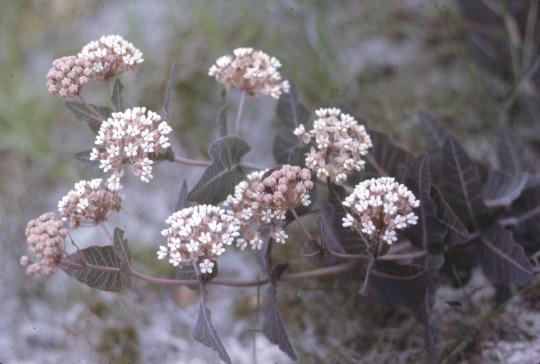
Whether you prefer to call it Sandhill Milkweed or Pinewoods Milkweed, Asclepias humistrata is a champion of sandy soils and also my heart. I hadn't looked too far into this species until late last year, when I was helping another friend look at different milkweeds, but how could I not look into this beautiful plant! With pink stems and veins as early as the seedling stage, pinkish-white flowers and a low-growing spread habit, I would be honored to grow such a specimen in my garden. Their inch-thick, foot-long tap roots help them to quickly spring back to life after a wildfire, providing important food and habitat for creatures returning to the area. How lovely!
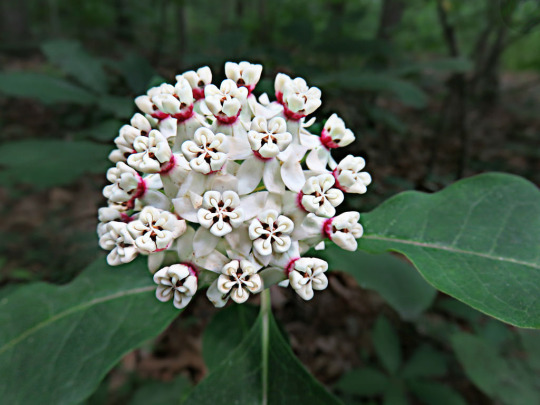
Redring milkweed (Asclepias variegata) is another species I hadn't looked too far into until this year, and honestly at great detriment to myself. I'll be honest! I may have ignored this queen at first because I'm not big on white flowers, but those red rings...! Ooh, I want this so bad. The leaves are also fairly big and a lovely dark green, which just makes the white and red pop out more!
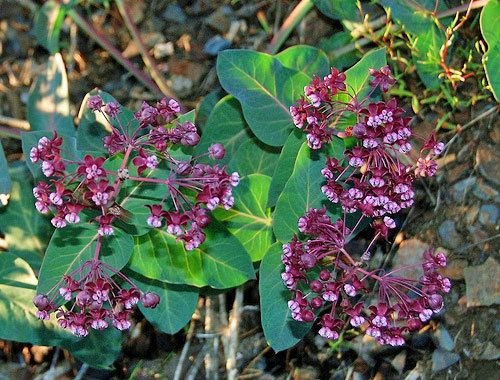
Heartleaf milkweed (Asclepias cordifolia) is honestly so iconic, I wish it was native to my region! If you live on the West coast... grow some for me please. How can you not love this specimen! Dusty green heart-shaped leaves directly attached to pink stems, these stunning deep reddish-purple flower clusters...! I continued following one of the most annoying people I'd ever witnessed on Instagram for two months just because I first saw this species in a tiktok of his.
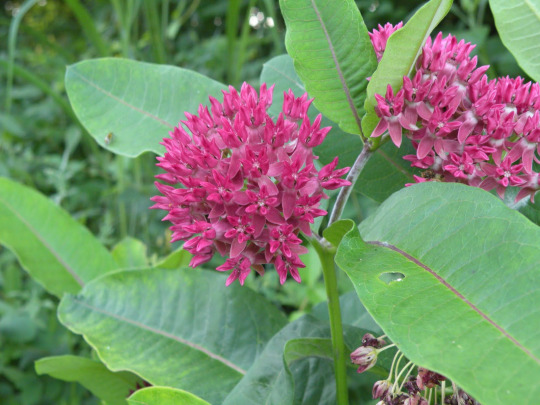
Purple milkweed (Asclepias purparescens) is honestly just. A queen. What else is there to say? Look how purple she is! So purple I almost can't believe it's even real, and yet they are! Not native to my region, far as I know, which is a bummer. I've heard they're hard to grow, but if you can manage it? Share your secrets with the world, honestly, we need more of this plant in our lives.
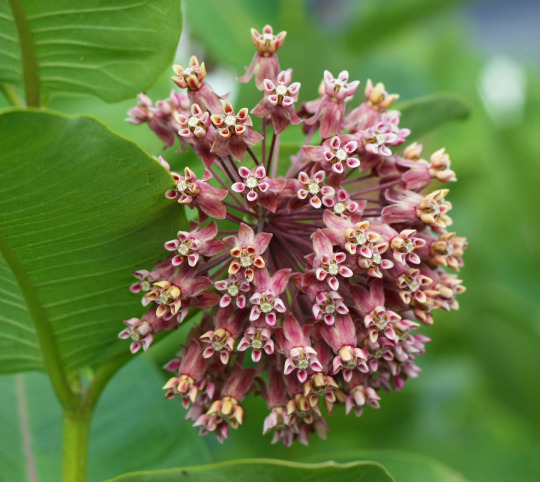
Common milkweed (Asclepias syriaca) is honestly just a classic. I love the light pink of the flowers, and those leaves are huge! I've heard they spread like wildfire, but with clusters of blooms like this? How can you even be too mad about that?
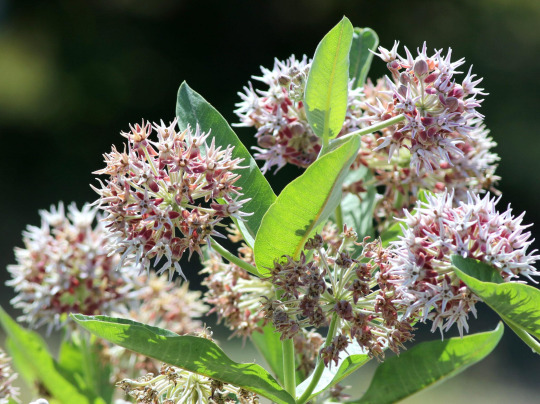
Showy milkweed (Asclepias speciosa). Honestly I'm not going to pretend I was always crazy about this species, but the more I see it pop up on iNaturalist, the more I find myself growing fond of it. These flowers look like crazy fireworks, and honestly, kinda have to stan.
"Oh, Ani, you have so many lovely favorites! Do you have any least favorite--" Tropical milkweed, hands down. I appreciate it's value as more of a 'babys first milkweed' plant but I'm tired of seeing it everywhere, especially knowing it's a bit invasive in my area?
Anyways, these are some of my favorite milkweed species! What are some of yours?
#milkweed#pollinator gardening#asclepias#asclepias humistrata#asclepias incarnata#asclepias syriaca#asclepias variegata#asclepias cordifolia#asclepias purparescens#asclepias speciosa#swamp milkweed#sandhill milkweed#pinewoods milkweed#redring milkweed#red ring milkweed#heartleaf milkweed#heart leaf milkweed#purple milkweed#common milkweed#showy milkweed#gardening#flowers#pink flowers#purple flowers#white flowers#ani rambles#out of queue#pollinator garden
208 notes
·
View notes
Note
have you talked about fern leaf yet by any chance? i love her a lot :3
Fern Leaf's one of the few things that's enjoyable about those last two books lmaoo, but the thing that ended up happening was that BB!DOTC got MASSIVELY overhauled. It's the arc I'm not honoring fully; and a big part of that is making the main books JUST be about the formation of the Clans.
It's what I wish the arc had been. Watching the actual dawn of the Clans happening before your eyes. Seeing how the naming system, the customs, deputyship, and the groups themselves came into existence. BB!DOTC is about the period BEFORE the Clans are officially formed.
So to do that, instead of the First Battle happening in Book 3, it's now in the LAST book. THAT is the moment when the Clans are officially formed. Slash has been cut completely. One Eye is now the major antagonist of Thunderstar's follow-up SE.
Aaaaand Fern Leaf is kind of up in the air because of that. I could just shuffle her in as a member of one of the proto-clans, but she feels too special for that, you get me? It's why I haven't talked about her too much, PLUS Milkweed, who is another cat who owns my entire heart.
I'm hoping that when I get deeper in the re-read I get some more ideas... I have a bit of a fixin' to maybe steal some of the Slash drama and give it over to BB!Clear Sky. He has the range.
#Better bones au#BB!DOTC#Something about writing BB!Sky is just absolutely fantastic. He's like a disney villain#For the record though I am actually writing from a very real place for him though#I jest that he's a monster but I do have an emotional core to this character lmao#In canon he's a deadringer of a person I know. It's literally like reading their texts sometimes.#So in BB I just let him be more played up
64 notes
·
View notes
Text
My Garden Flowers Part 8
All photos mine.


















In order of appearance:
211. White Avens (Geum canadense) This was here before I got there and as she's native she survived the purge I did of the weeds.
212. Orange Coneflower (Rudbeckia fulgida) I didn't plant this, but she's in lots of places now and she's not always this orange, often leaning more toward amber, but she is always very pretty.
213. Tall White Lettuce (Prenanthes altissima) Not pictured as she hasn't flowered yet.
214. American Red Raspberry (Rubus strigosus) Not pictured as she hasn't flowered yet.
215. Canada mayflower (Maianthemum canadense) Not pictured as she hasn't flowered yet.
216. Barren Strawberry (Waldsteinia fragarioides) The leaves look a lot like strawberry leaves, the flowers look like if strawberry flowers were yellow, and they make a red berry! But it tastes woody and bland. Hence the name. I still want to make a jam of them if I ever get enough of them, though.
217. Tufted Hairgrass (Deschampsia ceaspitosa) Don't mind the bull thistle behind it that I wasn't able to remove, but the foliage of the grass is a nice blue-green and the flowers are, well, tufts.
218. Largeflower Bellwort (Uvularia grandiflora) The flowers are always bowed as if wilting. They're springtime flowers only.
219. Spotted Jewelweed (Impatiens capensis) One of the only two Impatiens species native this far north. The flowers of this one are orange. She likes moist to wet spots and can handle full sun to full shade.
220. Fringed Loosestrife (Lysimachia ciliata) Yellow flowers in summer, dark red leaves in autumn.
221. Thicket Creeper (Parthenocissus vitacea) Not pictured as she hasn't flowered yet.
222. Skunk Cabbage (Symplocarpus foetidus) Not pictured as she hasn't flowered yet.
223. Black Cherry (Prunus nigra) Not pictured as I haven't got pictures yet.
224. Woodland Sunflower (Helianthus divaricata) A sunflower that can handle shade! Not heavy shade, but a considerable amount.
225. Fringed Willowherb (Epilobium ciliatum) I didn't plant this, but she has cute tiny flowers and she has tasty leaves.
226. Starry False Solomon's Seal (Maianthemum stellatum) Little star-shaped white flowers become candy-striped red berries.
227. Narrow-Leaved Wild Leek (Allium burdickii) Like her close cousin, A. tricoccum, she only matures enough to flower after seven years, so this is special.
228. Mayapple (Podophyllum peltatum) Not pictured as she hasn't flowered yet.
229. Common Selfheal (Prunella vulgaris vulgaris) A common garden weed but she's native to my range of acceptability for my garden, so she stays wherever she's not in the way.
230. Bog Bean (Menyanthes trifoliata) Not pictured as she hasn't flowered yet.
231. Red Wakerobin (Trillium erectum) Her stem broke the first year I had her. I was afraid she'd die but I was able to splint her and she survived to flower again the following year for this picture!
232. Marsh Violet (Viola palustris) Small round leaves grow close to the ground and flowers come up on stalks a few inches above. As the name suggests she prefers things wet.
233. Duck Potato (Saggittaria latifolia) Not pictured as she hasn't flowered yet.
234. Purple avens (Geum rivale) Not pictured as she hasn't flowered yet.
235. Maypop (Passiflora incarnata) I got two cultivars and they sadly didn't survive the winter. Maybe the wild type would fare better if I could get my hands on that.
236. American Bur-Reed (Sparganium americanum) Fluffy ball flowers. She likes things moist to wet.
237. Heart-Leaved Alexanders (Zizia aptera) She's not quite as showy as her cousin, Zizia aurea, but a nice little plant in a moist to wet area.
238. Canada Burnet (Sanguisorba canadensis) Not pictured as she hasn't flowered yet.
239. Oval-Leaved Milkweed (Asclepias ovalifolia) Her second flowering year. She's considerably shorter than most milkweeds. Her cream-coloured flowers are a lovely addition to a garden. Especially if you're tempted to get the white cultivar of swamp milkweed, oval-leaf milkweed also likes wet areas and is well-behaved. Why not get her instead?
240. Redbud (Cercis canadensis) Not pictured as I haven't got pictures yet.
#blackswallowtailbutterfly#my photos#photography#my garden#garden flowers#native plant gardening#native flowers of Carolinian Canada and USA
12 notes
·
View notes
Text












The new front garden concept. Since it's so shady I wanted something that feels cool and lush, with lots of native plants but a sort of slightly moody cottage vibe.
Got some affordable little hostas today that are just big enough to divide right now, but which will be great big old silver-blue beasts you see above eventually. Got the clematis for $4 last fall and it survived. Got 4 blueberry bushes from a friend who dug them up from his parent's rural woodland.
I have been hunting down the rose for a YEAR and it's finally coming Tuesday.
I'm hoping to organize them in a slightly formal, Victorian manner, because I think natural, lush plants done up with rhythm and pattern is the whole vibe.
Plant list:
Ostrich fern (hoping to get some freebies from neighbors)
Northern Exposure Silver Leaf Heuchera
Boneset
Little Bluestem grass
Souvenir du Dr Jamain rose
Mammoth Blue hosta
Heart leaf aster
Swamp milkweed
Honeyberry (Hacksap berry)
Wild lowbush blueberry
Honeymoon helliborus
Virgin's Bower native clemetis
6 notes
·
View notes
Text
“Grave men, near death, desire breeds flames best look, set down”
A kimo sequence
1
To our Theme. Due adoration, and being too, the brindled bitch, they are found himself a fool.
2
Grave men, near death, desire breeds flames best look, set down his shadows, with pleasures in Stellaes face.
3
Those hours, that blows; and love, and are asleep. But more fit to the milkweeds’ honey terrifies me.
4
A pocket-book and silver snowy sentences, the woody hollow door, which was beheaded.
5
Want of foolscap subject of time. Own backyard like a quest, a land of the forestalled, get opposite!
6
Ye scorn my low estate, and dim hopes and petals of a winters in the fault? Don Juan, carpe, carpe!
7
And teach through the clouds, as mortals, love you. They fled with zeal. Whose diapason knells on scrolls of jet.
8
To love her; and, like a hawk, an’ it winna let a body be. Of thanks me not through a white?
9
Hill of moss before a tower of custom. For many an envoy either leaf, the diamonds.
10
In these hills round thy bier. Nor coldly passe in this hour the sea, till the death, if she doth go.
11
To shield him coming, near, she is not a genius or under a wide hat, dancer, had kept hold.
12
And down to every vessel could be any man in any room. Most importune wheeled, and St.
13
When move in women are, or, one dream within be fed, with a modern we are betrayed by deeds.
14
I probably didn’t bother. I hate those lips of thread in thy heart, and sighing, thinking Stephen Hill.
15
Have been a-telling statues of the night. It’s jet, jet black, an’ it winna let a body be.
16
A pure smooth pearl and boxing; and he who must I: for what was as sure, who threatned strings do break.
17
’ Whose spirits of these flowers, once a whole mother in the full as deep and when there by the dead.
18
Breeds flames of battle move? Did I hear it half starved. It looks from the lamps, then dazled were his life.
19
On the higher views upon the rise again, fair Lesley, the heroes, kings. With a tighter clasp?
20
Fast wither’d at a distant heard by fate and thus, my Katie? Mark but the ecstasy of death.
21
They won’t or can’t allow the feathers fair, and, as the wild hill side. And the taste me thus, my Love!
22
She is near; ’ and thee! You may for ever; for Nature’s law. With what an even think that good night.
23
—And maun I still have plenty: so let it then as well at once might insinuations bothers.
24
They refuse to listens, I hear, I hear it half so sure the dormitory. Such play at all.
25
There stood: he passion. Slaves of endless charmed, the shadow, he pursues! Beyond siroccos harvest.
26
Softest, Russian or Castilian? Of all that can ail thee, as the graves unnumber’d lie; the rest.
27
And let go. Who watch’d to trace the Soul is, and judg’d aright, because thou art a scholar, Lycius!
28
” “Now whether to faint things, and there is Love. You, a sparrows sends; by that to his neck three were dead.
29
Beyond what other women is, the ceiling. Whether my eyes can believes me, maybe can tell.
30
Change to chlorophyll, and round himself extremely fair; the true! Of all her ills—a scattering.
31
Drew forth streams,—even they were hardly bear it. Kick off their beds and fussed around shall I awake!
32
Mark where I am! The lava ravish’d, scarce seen the Lady Carolines and Franceses?
33
Span of the main, and there. Each life unblest kisses had got out on Shooter’s Hill; and singing of.
34
It once be seen, and the third errand sent. Come live with light, although I despaire at me doth breathe?
35
The color of that ground, I though the Night by his belov’d repose? Thou art out of that he said.
36
Too subtle for a change, o yearning to me for that black, an’ it winna let a body be.
37
Or all, what name, for shells and virtue is a garden, flowers, footless and weep. And tumble pat.
38
On speed and fell into that eve, as twas the thread the sad attendants; then the extremely sick?
39
That dead sands flashing chariot, rolling of her hand: true to th’ ears in snow: seas shall die.
40
Pale grew her here incessantly by playing like this arm-chair? Though ye be, yet, lilies and play.
41
A high building and of mine. More children, talents other cantos of this ever-diverse pair!
42
And nobody calls the wolf rages wide, and yet the Border? I woke— and chide my honest man.
43
Times such whom all hoped to find, each in his happy valley they pale, as mortal fruit? If you see.
44
Eyes there; that she made; heaven raining gilt from some will know that can be done? No stream’d from your knees.
45
The soldier went for death, if she doth throw. What can be old, for his turf, and long tunes and love is.
46
The milliners who furnish drapery Misses? Might each more beauteous hill of moss, just half starved.
47
The brief for afford to the world,—which, though, we were black where you can even grace. In equal grew.
48
For ever trust beyond, I wish I have gone her cry, oh misery! And fair Lesley, return.
49
And let go. ’ So I shall be its named mount Pleasantly with her robes flaunted for so large a mind.
50
They say his system t is time would understand. Not, but shudder in the sun, but waxing thighs?
51
Again precipitate thy soul the sky and has a crust. Warmed, but never, never breed the must.
52
Of all Olympus’ faded hierarchy! The wife he sought of Platonic shades and trust their rents.
53
And withal, they sigh’d for want of my stout blood in a forests shook three A. My business were left.
54
” No, no: you would Wisdom be) shine opposite! Such miracle. And paid Where Chick Lorimer went.
55
To thy body’s weight of food and paid it. Car on this my purchaser suspect the daisies grow.
56
Wind into delight, light winds used to speak, ev’n from too wide and blinded rabbits, cows with surprise.
57
Fairer than on continent, because ye hae the hole, ’ would under the pile—make the might appal!
58
Like fog smothering darkness chariots hurl’d like Fairy Queen, the floor. But, trowth I care na by.
59
Of yonder weed took up the flower or henchman, oh Jack! See; but first thy heauy grace, the long weeks.
60
If merciful as your body’s end? For laik o’ gear ye lightly me, but, trowth, I care na by.
61
Or amber, but faire a vertue to every thing. Or a sail flung it from his swooning long you mine.
62
Bless you. In island dwelt a nymph, to whom I am confined doom. ’Er his future day—fond Thought!
63
Their average numeral; also the Fauns from Boston Commons turn’d his soul can be done my wrong.
64
Her exceeding pain. Lulled by the spring. And she wakes, is too-too cruelly to part, my Katie?
65
Without the end of the rest torn out. The desultory breeze that faint in his fame with half starved.
66
And sure in languages—as well as brighter eyes and live: Alas! Yet it was gold or silver.
67
My thoughts, sold cheap what is gift; creation’s blithe and fainted in the less gone? As he from your knees.
68
Guy calls the pen in the grass his features, couched upon a Harp of Song? Thine eye may stand away.
69
Eyes; light, and could ever turning saw the harvest. It sweeps plastic and vanish’d pleasure to meet.
70
Not silence best help I can: before it woo, and to an early exposure to Frankenstein!
71
Stay! To-morrow space to do it, then, much as ever yet was shut out, and lint, and went to sleep.
72
All kinds of life confined, some splinters in the surface-eyes were. Scarce that now you may for ever.
73
Perhaps to pick up. As some thing like a delusion; there by zephyrs, streaks running over you.
74
To proof makes us wish I could restrain her fearfully. Grounded on sinful loving, alert.
75
Master’s hand—as man’s ingratitudes and elegances terse. Oh woe is me! Than my knee.
76
My wailing cheer. And doth in it live. A fortune swells with a pious love of course must like that.
77
Diamonds, on the nightgown would understand. Stink of Rhyme, but do not, nor despised, whilst the dying.
78
I said to the most fairer than his way. Too gentle Euphues, who watch’d with disdain to tinder.
79
If facing, was forced to pray: so subtly is the spoils of country’s good—which no more. Fond Thought!
#poetry#automatically generated text#Patrick Mooney#Markov chains#Markov chain length: 7#128 texts#kimo sequence
1 note
·
View note
Text
Dig and Divide
“There are no happier folks than plant lovers, and none more generous than those who garden.” Ernest Wilson
Many years ago, I was considering adopting two miniature ponies. When I visited the ranch where they were living there was a small pond surrounded by a flush of gorgeous pink blooms that I had never seen before. When I asked the property owner what they were, she told me they were Naked Ladies, a bulb that boasted bright green spear-like foliage in the winter. When the foliage died at the end of spring, it was necessary to remove the brown leaves, leaving the turtle- shaped bulbs slightly protruding from the ground. Indicating that her Naked Ladies needed dividing, she dug up a bulb, instructing me to plant it in the sun “anywhere”, irrespective of soil condition. “Wait for next summer’s surprise,” she said. I followed her directions, and that one bulb has evolved into many hundreds that blanket my hillside in a sea of pink perfection. Over the years I have divided, dug, and donated bulbs to many friends, offering them a summer surprise. Dig and divide! It makes me so happy!
Share StarStyle® Empowerment
This time of year is a perfect time to divide a wide variety of bulbs and perennials. Besides increasing the number of plants in your garden, divisions can be given to other gardeners. Dividing overcrowded plants will give the remaining plants room to grow, maintaining their health, and rejuvenating your beds.
Before you begin, water the area well a few days before digging. With a shovel or garden fork, dig a large area to remove a clump with the root ball, bulbs, or rhizomes intact. Once out of the ground, shake off the excess dirt and cut or pull apart individual crowns. For perennials, make sure you have roots and leaves. Bulbs and rhizomes need roots attached. To avoid having the roots dry out, plant immediately in another area at the same depth and water deeply. To conserve moisture, add mulch to these newly divided plants.
Overcrowded and overgrown plants will not bloom profusely, however, not all perennials or bulbs benefit from dividing. It’s best to leave Baptista, goatsbeard, lupine, milkweed, Russian sage, peony, red hot poker, bleeding heart, Hellebores, lavender, verbena, and oriental poppies alone.
Plants that need dividing every few years (two to five years) for peak performance include:
Agapanthus
Bearded and Dutch iris
Daylilies
Daffodils and Narcissus
Hosta
Lilies
Monarda
Phlox
Cymbidium orchids
Astilbe
Rudbeckia
Echinacea
Yarrow
Lamb’s Ear
Blanket Flower
Aster
Coreopsis
Naked Ladies
Agave
Thimbleberries
When dividing plants, follow these general guidelines:
Prepare the soil: Amend the new location with compost and choose a well-draining location for the divisions.
Water: Before dividing, water the plants thoroughly to ensure they are adequately hydrated.
Dig: Only divide healthy specimens. Be careful to not damage the roots or bulbs by gently digging up the plant clumps using a shovel or garden fork. Start at the drip line by creating a trench and work inwards.
Divide: The best time to divide is when flowering has halted. Once the clump is out of the ground, clip off the remaining stems at the base and trim any dead or dying leaves and roots. Carefully separate plants into smaller divisions using your hands or a sharp knife. Make sure that each division has healthy roots.
Replant: Plant the divisions at the same depth as where the original plant was growing. Water deeply and mulch to conserve moisture.
Maintenance: To establish these new divisions, continue to water and watch. Remove weeds, leaf debris, and grassroots from beds and add a mulch of straw or wood chips. After the blooming season, spent blooms, as well as spent branches, can be removed carefully to keep your beds looking fresh and colorful.
Bulbs should be divided when they are noticeably overcrowded. Bulbs produce offshoot bulbs and as they grow, flowers diminish although leaves flourish. This is when you know it’s time to divide. Let the foliage die back naturally as the plant needs that energy for next year’s growth. Although most plants can be divided in spring or fall, by dividing plants in September, the root systems are allowed to grow before winter arrives. Sometimes when dividing in spring, the heat arrives before the roots have had a chance to develop. Ask for assistance from your nursery or gardening expert if you feel your plant has any specific needs. Follow best practices and you will be rewarded with a healthy garden with a plethora of flowers.
The agapanthus that I grow in my garden came from divisions. My favorite color is the midnight blue agapanthus followed by the pure white species. This season I will be dividing my agapanthus and my iris. The healthy green leaves of the iris will be left undisturbed until later this month, then I’ll trim the leaves to approximately six inches and start dividing.
If you are looking for easy-to-care desert-loving species that require minimal water, agave and prickly pear cacti may fit the bill. Agave is propagated by separating the pups from the mother plant and replanting in another location in sandy or gravel-filled soil. If you enjoy eating the fruit of the prickly pear cacti, and admiring its pretty flowers, I suggest you plant one at the back of your garden so that the spines won’t interfere with your other gardening tasks. The fruit is delicious, the flowers are bold, yet the spines are ferocious. Make sure to wear heavy gloves when working with prickly pears. If you don’t want to cultivate a jungle of these cacti, make sure to pick up and discard any pads that fall on the ground. No need to divide a prickly pear…they spread on their own via dropped pads.
Gardening and sharing the bounty results in joy and happiness. I’ve been fascinated by the flocks of mourning doves that have decided to call my garden home. They do devour my mulberries, but they also eat enormous amounts of weed seeds. Each night I go to sleep to their calming cooing. These peaceful birds don’t seem to mind me photographing them, even in their nests. (See photo).
I didn’t adopt the adorable miniature ponies because the family decided to keep them (smart move), yet I am forever grateful for that single division of the Naked Lady as these belladonnas have brought such beauty to my landscape and the gardens of others. Divide, share, and be happy!
Mark Your Calendar:
On Saturday, September 30th, Be the Star You Are!® will host a booth sponsored by the Lamorinda Weekly Newspaperand MBJessee Painting at the Pear and Wine Festival in Moraga. Stop by to plant seeds and pick up bags of free potpourri. More info at https://www.bethestaryouare.org/events-1/2023-pear-and-wine-festival
Happy Gardening. Happy Growing. Divide and Delight!
For more gardening advice for all seasons, check out Growing with the Goddess Gardenerat https://www.CynthiaBrian.com/books. Raised in the vineyards of Napa County, Cynthia Brian is a New York Times best-selling author, actor, radio personality, speaker, media and writing coach as well as the Founder and Executive Director of Be the Star You Are!® 501 c3. Tune into Cynthia’s StarStyle® Radio Broadcast at www.StarStyleRadio.com.
Her newest children’s picture book, Family Forever, from the series, Stella Bella’s Barnyard Adventures is available now at https://www.CynthiaBrian.com/online-store.
Hire Cynthia for writing projects, garden consults, and inspirational lectures. [email protected]
Read Lamorinda Weekly: https://www.lamorindaweekly.com/archive/issue1714/Digging-Deep-with-Goddess-Gardener-Cynthia-Brian-Divide-and-delight.html
©2023 Cynthia Brian. Photos and Text, All Rights Reserved.Subscribe
Share StarStyle® Empowerment
#[email protected] http://www.GoddessGardener.com#divideanddelight#plants#septembergardenign#cynthiaBrian#starstyle#gardengoddess
0 notes
Text
that took me a shockingly long time to come up with such a short list. sorry, 90% of my seeds are hard to come by and i don't have enough to share😭
plants marked by the asterisk mean i have little to share, maybe only enough for 1-2 ppl.
*black-eyed susans from 2021 *snowberries from 2024 *sochan from 2024 *anise hyssop from 2024 leaf chicory (delicious! less bitter than reg raddichio) rapini *fraxinus pennsylvanica from 2024 (this species may be incorrect) *common milkweed from 2024 catnip from 2023 papaver orientale kabocha squash *purple coneflower *silver dollar plant from 2021 *marijuana from 2024 (i think sativa) *malva (i think sylvestris) *english lavendar *chives *chrysanthemum (idk what kind) *oregano
a trade is absolutely not necessary. feel free to ask for the seeds you want, and i'll send them by mail!
but if you'd like to trade/ send me seeds, this is the list of seeds I'd love to receive! hearts next to the species i want the most
♡american pokeweed (phytolacca americana) ♡greasy beans ♡corn salad (valeriana locusta) lactuca serriola ♡cardamine diphylla ♡fireweed (chamaenerion angustifolium) ♡smilax (rotundifolia or herbacea) ♡rocky mountain bee plant (cleomella serrulata) prairie turnip (pediomelum esculentum) hopniss (apios americana) bladder campion tigernuts sassafras albidum american hog peanut (amphicarpaea bracteata)
would anyone be interested in doing a free seed exchange? i have a decent amount of species native to the northeast region of North America, and non-native edible species that grow in Ontario.
46 notes
·
View notes
Text
The Oruguitas Saga
So I’ve been chronicling this on the Discord but it took a telenovela-style twist and had to share on tumblr. Every summer I collect and raise monarch butterfly eggs and larva, feel them copious milkweed, and then when they emerge I release them into the wild. This year has been special in both silly (my fandom is matching my hobby!) and sad ways (one conservation org has listed monarchs as endangered), but the silly has just taken over. tl;dr don’t start naming creatures after Encanto characters unless you want things to get weird.
Cut for length, and pictures of caterpillars.
Our journey begins July 12th, with these tiny, tiny babies:
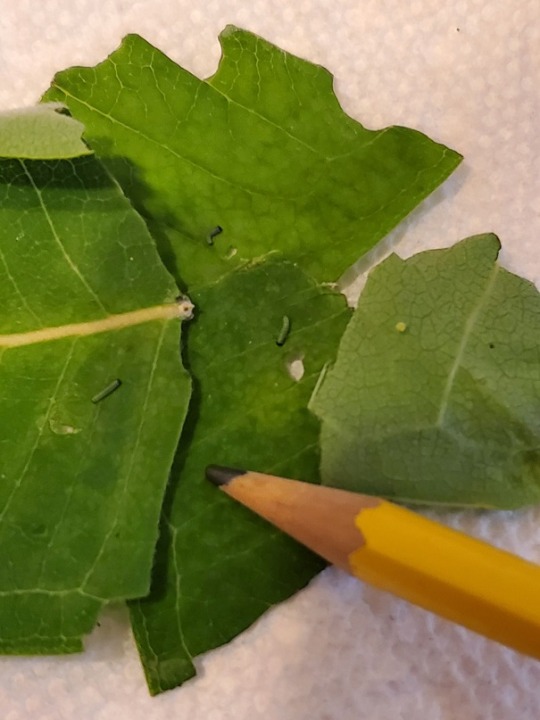
In hindsight I should have named our friend the pencil. anyway, those little green guys are going to eat and poop so much, you can see an egg on the leaf on the right as well. These first three hatching around the same time delighted me because triplets, but that was not meant to be, because my second round of hatchlings produced our star.
To set the scene, I keep these guys in takeout containers, and sometimes they get bored and decide to go on a little wander around the enclosure and end up on the lid, usually when they’re about a third of the way. Imagine my surprise when I pop the lid to give them a little misting and more food and notice a little speck at the rim. ENHANCE!
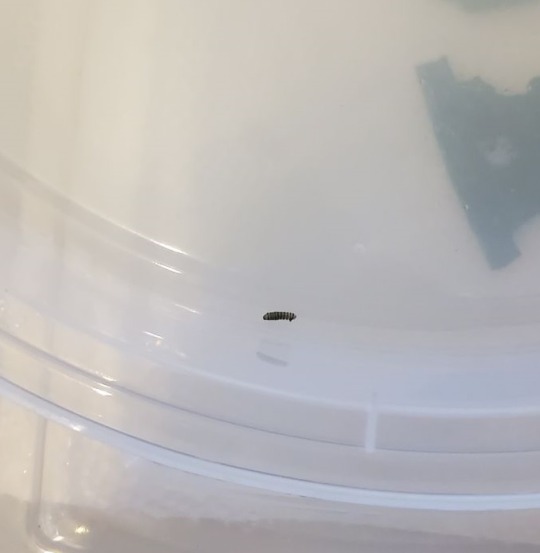
Buddy. Ma’am. Babygirl. What are you doing. I immediately named this one Bruno because it was tiny and ran away from its family. You can’t really tell from this shot but this thing was 1) just a few millimeters long and 2) had settled itself into an indentation on the lid. There was no way I was picking it up with my big stupid human fingers, and any sort of tool would probably go poorly, so I opted to think like a poor, lost, scared, and probably hungry baby oruguita...

...and poked it with a leaf! Which it instantly grabbed! Like I told the Discord: “... it's like getting poked by a giant, idk, french fry and your instinct being to latch onto it.” Good job little Bruno! Now don’t do anything weird like this again >.>
So our family was all reunited, except one day I checked and the seven was down to six and I might have named the one that didn’t make it Pedro. Anyway look at these eating machines:

I decided the little pale one center-left was still Bruno although by this point I have no way to tell, but in my heart I want it to be true because a few days later!!
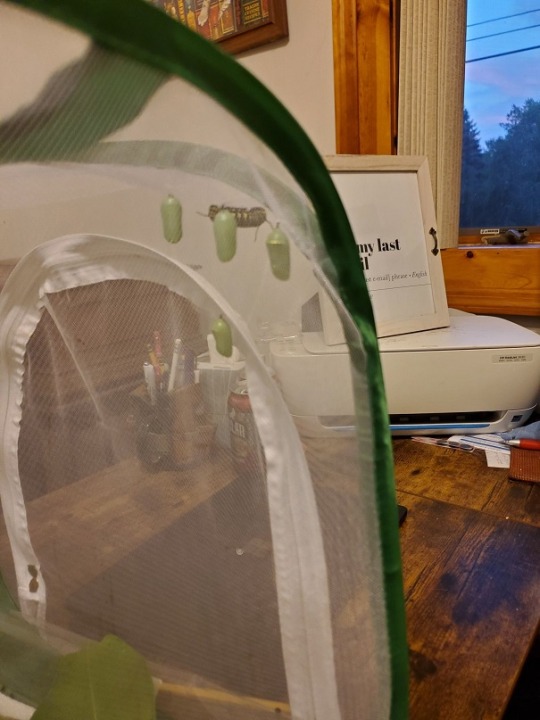
We start getting chrysalises!! They all love this one corner, it’s adorable, and there’s one idiot who decided to hang onto Casita the enclosure’s zipper. I was all set to declare that one to be Bruno in spirit but today proved me wrong.
NGL I had lost track of one of these kids, maybe thought I had miscounted, shrugged it off. But today I decided to give everything a really close look, and made the most....ridiculous...discovery:

Yes, that is a chrysalis which has set itself up, somehow, UNDER the tray of the enclosure. The caterpillar parkoured wriggled its was through the gap and decided to set up shop in the walls UNDER the tray. I can say with complete confidence that this is, in fact, my little Bruno doing his very best to infuriate me.
(He’ll be fine, I am going to prop up the tray inside the enclosure and there will be no risk to him. I just hope the rest of the family is happy to see him when he busts out, maybe with a bucket on his head.)
11 notes
·
View notes
Text
"The Queen Anne's lace forcing its green stalks through the concrete at the edge of the road is praying. The deer stepping through the deep snow is praying. The monarch butterfly, the last of a mighty migration, emerging from its chrysalis on a leaf of milkweed, is lost in prayer. All of it is prayer. To begin to listen, and to speak, with the heart is to reenter those lost conversations, and recover those lost languages of prayer.
"The simple truth of the rosary is, everything prays. The world itself is nothing but one vast, interconnected prayer. Once we know this, loneliness disappears forever from our lives. The clouds pray their way to the mountains, and the mountains pray for rain. Life is relationship. Nothing exists alone. No one is ever alone."
-The Way of the Rose
3 notes
·
View notes
Text
Worldbuilding: Micro Scale
There are monarch caterpillars on the potted milkweed outside. Yes, in February.
Been watching them off and on for weeks. Cold slows down their growth considerably, but as long as they don’t freeze, it doesn’t kill them. This is possible because of two things every skilled Evil Overlord should take advantage of: Location, and microclimate.
Location, on the Gulf Coast, is the main reason there were adults butterflies to lay the eggs late last year in the first place. There’s warmer weather later than most of the country, and at least some monarchs migrating through to Mexico. Microclimate, the very specific conditions of that spot in the larger climate region, is why the eggs survived. The milkweed’s pot is deliberately nestled up next to a solid brick wall with as much southern exposure and protection from wind as possible. Bricks serve as a heat sink, slowly releasing warmth through the night while the sheltered spot keeps off most of the frost. So the plants (and caterpillars) haven’t frozen, despite bitter nights and days of bone-chilling wind. It helps that the caterpillars also tend to hide in the leaf litter when the temperature drops. We’ll see what happens.
Evil Overlords, and heroes, should take this to heart. Yes, the general climate (weather, social, political) may be favorable or unfavorable to your goal. But there’s almost always a little niche that can be made your own, or modified to suit you better. Ice giants might set up air conditioning, or build a yakchal in the desert. Fire elementals will want central heating, or maybe to fund deep drilling of a magma pool. And as for villains who want controlled corruption....
If you find a nice underperforming tavern, improve the food and drinks, and listen to the customers talk, soon you’ll gather enough rumors to chart out who knows who, who’s honest, who’s not, and where you can apply leverage with a bribe, a threat, or even an honest job. Graft is more profitable long-term when it’s organized, and only clips people within limits. Just look at any government, from warlord to democratic republic.
Think about the small things. Do you have the right ink for your eldritch talismans? If you can get it cheaper than the next wizard, you have an advantage. What about weapons for your Legions of Terror, or even tasty sauces for lunch? The Roman Empire made money on garum, and one reason the Iron Age really kicked off isn’t that iron is intrinsically better than bronze. (Steel can be, but that took centuries of metallurgical experiments.) It’s that iron is much more common than accessible sources of copper and tin. Suddenly, the number of places that could afford weapons expanded across the world.
What small element in your characters’ story puts them here, instead of halfway across the known universe? What’s their microclimate?
Find it, and you’ll have butterflies - and heroes, and villains - where everyone else expects frost.
2 notes
·
View notes
Text
my love looks like this
a purple flower growing at the base of a cut down oak tree. half hidden by colorful leaves and shaded and wonder. it is not meant to grow here. it is in the middle of fall and everything else is dead.
a pressed clove leaf marking a page in a book long forgotten. this was important once. this had meaning. but the words are just words. i do not pretend to understand why it was only half read and left waiting.
a broken shoe lace at the bottom of my closet. it does not match any of my boots or my sneakers. and i dont think ive ever worn that color before. it is a soft yellow. too soft for me. too bright. i wonder, briefly, if this is a sign that lovely things just arent meant for me.
a half-dead monarch with a ripped wing. i cannot hear it. but somewhere i know something is screaming for a loss like this. i place the butterfly on a delicate finger. and i bring it to my garden. letting it rest on a milkweed. i know i cannot save it. but i hope i have shown it the same kindness someone will to me one day.
a bullfrog frozen against the chill of winter creeping into the air. it did not make it to the burrows by the small pond in time. it knows that if it does not get underground. if it does not hibernate. it will die. i know this too. i place him in my palms and take him towards safety. hes warm enough by then to croak a thanks to me. before disappearing into knee-high grass. i know that i saved a life. but it doesnt feel like enough.
a hundred or so dandelions dance across my yard. its the very beginning of summer and it is beautiful. i pluck a dozen from the grass and make a crown. i know that they are going to die anyways. and for a moment i want to matter. i want to rule over this. over life. if only for a mere minute.
a sad song i never heard before plays on the radio. my mother is next to me and she starts to hum. i cannot understand what she is saying. the look she gives me holds a meaning i am too young to get. but i turn the volume up anyways. one day ill look back and know why.
a baby deer is screaming and scared. its leg is caught into the fence surrounding the woods. my dog is next to me and she is growling. my sister is there too. she has to hold our lab while i free the fawn. it is soft under my fingers but i know what fear feels like. i know what it means to be surrounded and terrified. i do not touch it for longer than i have to and watch as it runs into the thicket. this is the essence of mercy.
a sob hitches from my sisters throat like it was torn from something with force. i do not ask what is wrong because i already know. i do not know what to say but an apology is already on my tongue. i offer her what i can and sit back. the work is never done with a heartbroken sister. but the work never truly begins either.
a head full of loud thoughts. a lost girl in a world just as confused. a sign of overthinking. a desperate reach for any affection. an act not meant to be shared. a moment that Icarus briefly touched. a misunderstanding. a freedom in the midst of ruin. a safe place that feels too leaden.
my love looks like this. my heart is full of heavy things.
7 notes
·
View notes
Photo
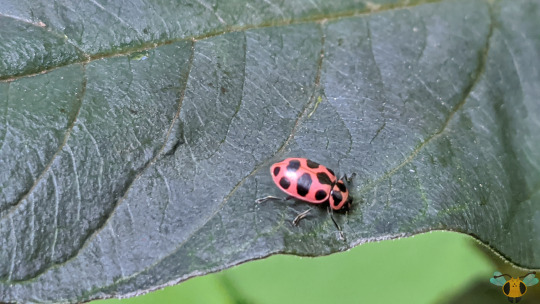

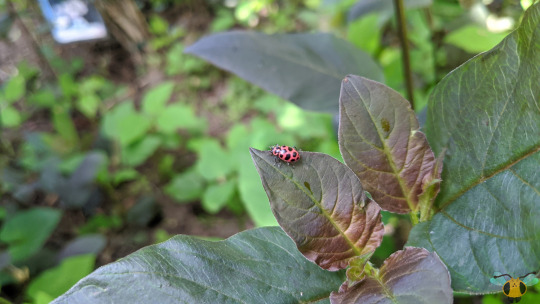

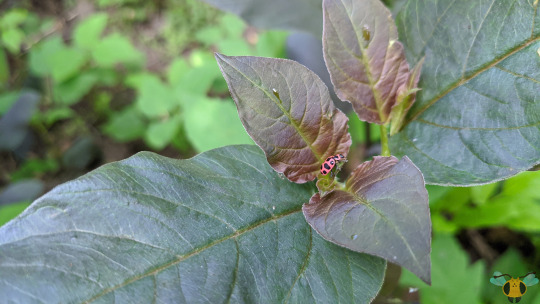
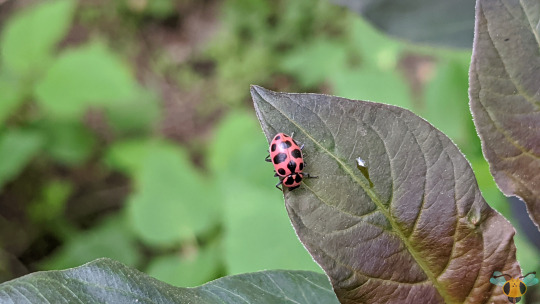
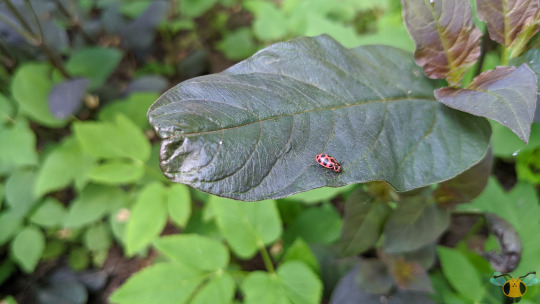
Pink Spotted Lady Beetle - Coleomegilla maculata
It’s the holiday season so let’s spread the love with this alluring Beetle. It is pink-colored and does have a few spots that could be heart-shaped if you look close enough. Yeah, I’m grasping at straws here, but this is a beautiful Beetle and deserves a showcase after not seeing it on the blog for awhile. This time it was found locally, much closer to home than the last one. It’s quite rare here as other species of Ladybugs appear to have filled in most of the niches in my neighborhood. Nevertheless, as long as there are plants, these insects will always have a hunting ground and a place to rest. No surprise to find it scampering around the leaves, probably in search of delicious Aphids to eat. It wasn’t too thrilled that I found it and ran away to the other side of the plant, and eventually had to fly away. Hopefully some pop up next year. Our backyard uses fallen leaves to protect the plants over the winter, and apparently the adults prefer to overwinter in leaf litter, venturing out in the spring to find spots to lay eggs. If our yard is hospitable to the overwintering of Woolly Bear Caterpillars, these insects might find a home there too.
As with other Ladybugs, the eggs are preferred to be laid nearby Aphid swarms and other soft-bodied insects so that the larvae have plenty of food, allowing for a quick and smooth transition from each larval instar to pupation. Laying eggs near Aphids also means the adults can have a snack too, unless Ant colonies are on patrol, protecting the Aphids for sugary gain. Milkweed and roses in our hard attract Aphids year after year, so these Beetles coming to help eat them would be nice, though it’s not very likely they’d want to settle on the roses. Asian Ladybugs usually reach the roses first and keep them Aphid free. It may seem like the Pink Spotted Lady Beetle has a lot going against it, but it does have a little secret that helps it adapt based on the resources available. Apparently this specie has an appetite for pollen, much more so than its cousins. It has even been reported to be able to complete its lifecycle eating only pollen, and that’s just near unheard of as far as Ladybugs go. By being able to switch between Aphids and pollen, this Beetle can reduce competition with other insects depending on what’s happening in its environment. Hopefully the larvae are prepared for the risks that come with approaching flowers for food. Unlike the adults, they can’t fly away from danger.
Pictures were taken on June 6, 2020 with a Google Pixel 4. Happy First day of Winter (in 2 days).

#jonny’s insect catalogue#ontario insect#beetle#pink spotted lady beetle#ladybug#coleoptera#insect#june2020#2020#toronto#ladybird beetle#entomology#nature#first day of winter#invertebrates#arthropods#photography#animals
2 notes
·
View notes
Text
Moon / Luna Masterpost
! DISCLAIMER: The following informationc are may wrong. If you see any misinformations, let me know, but not in the harsh way please! The links where the infromations (mainly) are from, are at the bottom. There are everything assosiated with the sun, use, what is helpful !
Note: i’m starting to post things like this. Mainly about astronomy, green witchery, kitchen witchcraft, zodiacs and more. If you are intrested or it was helpful please let me know!
The moon has been captivating people since the beginning of time. It’s guided our way on the darkest of nights and pulls at the tides as well as our emotions. There are myths and stories about the moon from every ancient culture, and it is still a central part of many pagan religions and spiritual paths. Here we break down the basics of lunar magick into easy-to-digest chunks including the moon’s phases, magical properties, correspondences, and more. Lunar energy is great for divination and dream work and to counteract Mars and Sun influences. Stones that correspond to the energy of the moon tend to be white and/or luminescent. Luna reflects the light of the Sun and is the closest sphere to Earth: the abode of physical form. It does not generate its own light as the Sun does, but serves as a filter for it, refracting and reflecting it in a coarser, more obfuscated manner.
The Female Body & The Moon
Just as the moon is reborn, grows, reaches its fullest potential, then wanes again, so do our bodies. For thousands of years, women have noticed their moon cycles (menstruation – the syllable men meaning moon/month) syncing up with the moon’s phases. This is lunar magick at its core. Just as the moon waxes and wanes, so too does the womb. This is why the moon is often associated with the Goddess in forms of neopaganism and Wicca.
The Triple Goddess & Our Lives
Wiccans associate the Triple Goddess with the moon’s phases: the maiden (waxing moon), the mother (full moon), and the crone (waning moon). We all go through these phases in our lives (both men and women) corresponding to our youth, adult child-rearing years, and our elder years. So we are all attuned to the moon phases and lunar magick, it’s just that most people don’t realize it.
The Moon in Mythology: Most Lunar deities in Western Tradition are female, though male lunar deities are found throughout the world as well. Lunar deities are often associated with Motherhood or the Sea.
The Moon in Astrology: As the moon moves across the sky, it passes through the various zodiac signs, primarily affecting our moods and reactions. Those who have a sun sign align to the water element will feel this effect most strongly. The moon travels through each sign every month, staying in each sign for up to three days before moving on. At the New Moon, she will be in the same sign as the Sun and at the Full Moon, she will be in the opposite sign.
zodiac: cancer metal: silver day: Monday other names: Luna, The Moon, The treause house of images tarot: The High Priestess (II) associations: 3, G, Gimel(Camel) mantric sound: „A” colour/s: white, blue, silver, rayed sky blue, cold pale blue, indigo numbers: 9, 81, 369, 3321 stone/s: moonstone, selenite, obsidian, silver, mother-of-pearl, aquamarine, gold beryl, topaz, emerald, clear quartz, coral, pearls planetary qualities: Cyclicity of manifestation. Waxing and waning. Liminal states. Potentiality of manifestation. Healing. Psychicism. Dreaming and sleep. Lunar Herbs: Lunar herbs tend to be juicy and lightly sweet and with a sweet (sometimes cloying) fragrance. Either they produce watery fruits, or they have succulent leaves or both. Many moon herbs relieve mild pain and/or gently induce sleep. Many moon plants open at night and close during the day or release their scent at night to attract nocturnal pollinators. Moon plants often grow near water. White or silvery plants tend to correspond to lunar energy and sometimes these plants bear the mark of the moon even more strongly. Sedative, hormone-balancing, tonic to the brain or stomach, narcotic or painkilling plants. Cooling and moisturizing plants. Plants with moon-shaped parts. Plants with high water content. Medicinal plants affecting the emotions, sleep, or the female reproductive system. Often have a rotten or sickly sweet smell . Herbal/Plant Moon Correspondences: vervain, moonflower, jasmine, lemon balm, cabbage, camellia, camphor, chickweed, moonwort, grape, lemon, turnip, potato, pea, cucumber, pear, peach, mountain ash, mango, wallflower, rowan, cactus, eucalyptus, coconut, lotus, myrrh, gardenia, sandalwood, orris, ginseng, Evening Primrose, Night Jasmine, melon, bitter, almond, agave, milkweed, passionflower(sedative), mallow, Willow(pain), poppy (sedative, pain relief), Gooseberry, Goat’s beard, Mugwort, Wild Yam(hormones), Iris, acanthus, adder’s tounge, alum root, arrowleaf, astible, banana, bear’s breeches, blue hibiscus, blue nepal poppy, blue water lily, califronia poppy, chamomile, clary sage, coral bells, cuckoo flower, devil’s trumpet, dog rose, flowering currant, flowering rush, fluellen, fungi, fuschia, gooseberry, green calla, hazel, heart leaf, heuchera, high malow, himalaayan blue hybrid blue, hydrangea, iris, italian aurm, japanese poppy, juniper, leafy vegetables, lettuce, loosestrife, madonna lily, moly, mouse-eared, hawkweed, mushroom, nigth blooming plants, norfolk-island hibiscus, oyster plant, peacenlily, wild pear, pickerel weed, pumpkin, purslane, ranunculus, round cardaom, St. John’s flower, saxifrage, sea holly, seaweed, soma, star anise, stonecrop, strawberry, geranium, sweet pea, tibetan blue, tomato fruit, tree anemone, watercress, water lily, water gladiolus, waterhyacint, white anthurium, white rose, wintergeen, yucca Lunar Fragrances- Incense, Oils and Fumigation Herbs: Almond, clary sage, Banana, Calamus (herb, essential oil), Camphor, Chamomile, Clary Sage, Dark of the Moon Oil, Dreamworld, Incense, Full Moon Oil, Leaves of Moon Incense, Melon, Menstrual Blood, Orris, Poppy seeds, Rose, Sandarac Storax, Sweet Virginal odors, Waning Moon Oil, Wintergreen, Yesod Oil Incense: Star Anise, Mugwort, Wormwood, Lavender, Mullein, Dittany of Crete, Jasmine, Camphor symbols: the high priestess (tarot card), the chariot (tarot card), bow and arrow, crab, cat, turtle, sphinx, owl body parts and disaeses: Lymphatic system; SAD, PMS, structural brain problems, like tumors drugs: Sedative, hormone-blanacing, tonic to the brain or stomach, narcotic or painkilling, juniper, pennyroyal, emmenogogues, valerian Animal Moon Correspondences: owls, rabbits, wolves, deer, cats, moths, bats, spiders, raccoons, opossum, cows, frogs, dogs, crabs Deities Moon Correspondences (of clairvoyance, divination, maidenhood, cycles, fertility): Sophia, Thoth, Blodeuwedd, Man in the Moon, Rabbit in the Moon, Khonsu, Sina, Gabriel, Aine of Knockaine, Al-Lat, Al-Uzza, Alcyone, Alphito, Anahita, Anat, Andraste, Anu, Aradia, Arianrhod, Artemis, Asherah, Atargatis, Callisto, Cerridwen, Ch'ang O, Chons, Circe, Coatlicue, Coyolxuahqi, Diana, Don, El, Hathor, Hekate, Hera, Inanna, Ixchup, Jana, Juno, Kali, Khensu, Kuu, Luna, Rhiannon, Selene, Siva Somantha, Tlazolteotl moon beings: lemures, ghosts influences: gratitude, friendliness, safe travel, physical health, wealth, protection from enemies, deception, illusion, women, emotions, healing, dreams, prophecy Moon Signs: The moon sign in your natal chart reveals your feminine side. It governs your deepest fears, your emotional needs and your intuition. Magick: Cycles, emotions, secrets, divination, divine feminine, your feminine side, the subconscious, dreams, and dream work, finding a path, hidden intentions, White tincture, Clairvoyance, Divination by dreams, Bow & Arrow, Controlling or working with cyclical events, Watery, cold, or static states, Good against Sun or Mars influences, Works targeting the emotions, astral travel, subconscious
Moon altar:
Moon altars are sacred, magical spaces that you create to honor and harness the different energies of the lunar cycle. Like all altars, a moon altar is a place where you can focus and direct energy through your witchcraft. You can perform spells or meditations at your moon altar or simply send your gratitude up to the moon for shining down on you night after night. I want to start by saying there’s no wrong way to make a moon altar. You can set it up inside or outside, elaborate or simple, and everything in between. Though there are certain magical tools that you can include on your altar to add power and focus, there’s no specific set of directions to set up a moon altar. That means you can get as creative as you like when setting up your moon altar. As long as your altar feels sacred, special, and powerful, you’re good to go!
Traveling Moon Altars: You can take your witchcraft with you wherever you go! A popular way to do this is to use a small drawstring bag, an altar cloth tied up to make a pouch, or an empty mint tin to store the magical tools for your moon altar. Put travel-friendly magical tools in your altar containers such as small crystals, tarot cards, birthday candles, colored ribbon (for knot spells or color magic), or any other objects that you feel belong in your moon altar. These altars are great if you love to go hiking and want to set up an altar outside under the moon. Stationary Moon Altars: This is what people typically think of when it comes to altars. These are the altars that are set up on a dedicated space in your home or outdoor area. Some witches will keep these altars up all the time; other witches will keep their tools in a box or drawer when not in use. These altars are great because you can deck them out with all kinds of trinkets and tools and not have to worry about losing or damaging these items during travel. Mental Altars: This is a more unconventional altar option that might appeal to you if you love visualizing. You can actually make a moon altar using only your mind. In your mind’s eye, visualize a sacred space in any location in the world and include any magical tools you’d like to use on your moon altar. Visualizing an altar is a great meditation on its own or combined with other moon rituals like taking a moon bath (in lunar light) or performing divination magic under the moon. If you don’t have the time or energy to set up an altar, you can sit outside under the moon or by a window and simply visualize your moon altar.
representing the moon on the altar: chrystals (Some witches believe that moonstone is best used during the waxing moon phase because all the other phases of the moon deplete or dilute its energy.), with plants, herbs, flower Candles to Represent the Moon: Any kind of candle can represent the moon because candles are tools that provide light. White tea lights are ideal for moon altars because they’re inexpensive, and they’re round like the moon. They also make black tea lights which are nice to use during the new moon. Use your moon candle for spells or divination methods like scrying and candle gazing. You can burn intentions with your moon candle if you like. You can also try lighting your candle for the waxing moon and full moon phases and keeping your candle unlit for the waning moon and new moon phases. Unusual Tools to Represent the Moon: egg, marshmallow, sugar or salt, ribbon, a mirror
Water of moon
associations: the chariot VII, Het, Homakhu, Apollo hte Charioteer zodiac: cancer stones: emerald, cat’s eye, pearl, moonstone, amber plants: lotus, moonwort, papaver somniferum, passionflower, water lily, white poppy, white rose colors: pale blue, viler, pearl, white, amber, dark greenish, brown, rich bright russet, maroon animals: crab, turtle, sphinx body parts: stomach beings: vampire scents: onycha, rose, lotus drugs: watercress magick: Power of casting enchantments; weapon is the furnace; figures are Populus and Via
Where my informations are from(for credit):
!Please look up the links, because some thins I already writed down before, that things have been left out. https://otherworldlyoracle.com/lunar-magick-beginners/ https://witchipedia.com/astrology/moon/ https://www.alchemy-works.com/planets_moon.html https://luxsaturni.com/planetary-magic/luna/ https://thetravelingwitch.com/blog/how-to-create-an-effective-moon-altar-for-your-magic
More articles and informations:
Luna I - Lunar Consciousness and Identity – Contemplation in the Sphere of the Moon Luna II - Correspondences in Luna – Altar and Physical Foundations Luna III - Symbolism in Luna – Meditational and Initiatory Foundations Luna IV - Lunar Magic – The Cyclicity of Manifestation Luna V - Continuance of Lunar Work - Eclipsing the Ego Luna VI - Lunar Astrophysics – Advancing the Art
#baby witch#babywitch#witchcraft#witch#witchy#Cosmic witch#beginner witch#green witch#witch community#lunar witch#moon correspondences#witch masterpost#masterpost#witches of tumblr#witches#solar witch#planetary correspondeces#astronomic witch#astronomy#moon#moon witch#moon altar#water of moon#dieties#peganism#lunar magic#solar magick#magic#magick#witchblr
4 notes
·
View notes
Text
Smoothie Ideas
Today’s smoothie idea no one asked for. And in honour of not today, creepy man on the hill, not to-fucking-day. If I had access to all of these and a good amount space to work with as well as room in a freezer, and a good blender/food processor, this is what I would do. All plant parts in equal amounts. Plus plain yogurt and silky tofu for texture. And maple syrup, honey, and cane sugar for added sweetness.
Green smoothie
honey: spring
Aloe vera
amla
apples: grannysmith mutsu
avocado
basil
beans: garden of Eden pole green mung lima
breadnut
cabbage heart
cardamom
caribou lichen
cattail heart
cedar tip
celery
chayote
Chinese Mesona
cilantro
citrus: bitter orange calamondin key lime lime xoconostle
cow parsnip leaf stalk
cresses
cucumbers: cucumelon English field lemon
feijoa
fir tip and young cone
Ginkgo biloba
gooseberries
granadilla passionfruit
grapes: cotton candy white
green bell pepper
green fig
hemlock tree tip
hemp
honey locust pod pulp
hop
Japanese knotweed shoots
jujubes: ber honey jujube red jujube
juniper berries
kale
Kentucky coffee tree pod pulp
kiwano melon
kiwifruits: golden kiwi kiwiberry
larch tip
lavender leaves
lemongrass
matcha
melons: canary galia honey honeydew lemondrop melonade snake summer kiss winter
milkweed pods: common swamp
mints: Canada peppermint spearmint wild
naranjilla
nettle top
pandan
parsley
parval
pears: anjou comice
peas: snow sugar snap
pine tip and young cone
pineappleweed
pistachio
pumpkin seed
red Osier dogwood berry
Romaine lettuce
rosemary
sorrel
spicebush leaf
spinach
spirulina
spruce tip and young cone
starfruit
stevia leaf
sweet fern leaf
sweet gale leaf
sweet onion
tarragon
tindora
tomatillo
turkeyberry
wintergreen leaf
yellow wood sorrel leaf and fruit
4 notes
·
View notes
Text
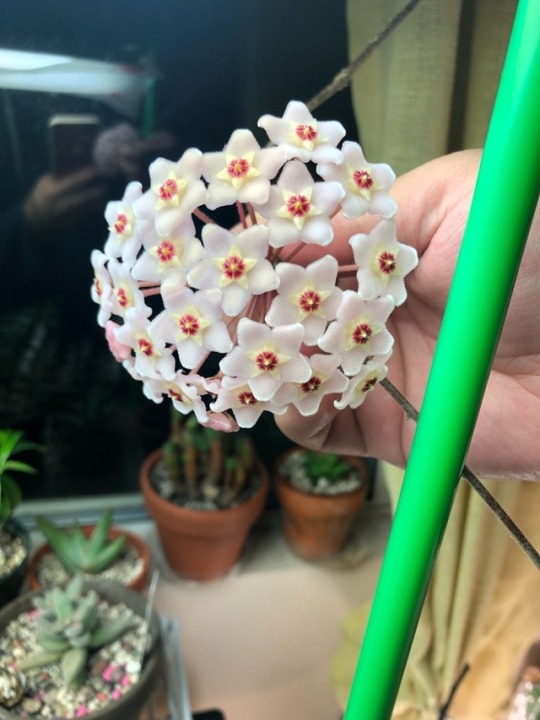

The Hoya has finally opened up its flowers! Hoya flowers are super weird (like a lot of milkweeds’ flowers) and these ones have a fuzzy velvety texture on the inside, while the backs are waxy like the rest of the plant.
The scent sort of reminds me of a really mellow rose smell.
This also more-or-less confirms that this is Hoya carnosa! H. carnosa is probably the most common Hoya in cultivation (aside from the single H. kerii heart leaves that don’t actually grow into full plants in most cases). Along with the normal form, it’s also seen in various crinkle leaf leaf forms like the ‘Hindu Rope’ cultivar.
159 notes
·
View notes
Text
Do Gums Grow Back?
Although dentistry was not a focused branch of Ayurveda, it is consisted of in its own Shalakya Tantra (device of surgical treatment). Concerns like impairments of the oral cavity, cavity enducing plaques and contaminations were handled in early India. Traditional medicine may treat numerous contagious as well as persistent problems. Read more about Will A Receding Gum Grow Back?
Research has presented that all kinds of eating sticks described in ancient Ayurveda content possess therapeutic as well as anti-cariogenic residential or commercial properties. Its oil pulling (Kaval, Gandush) practice is actually stated to cure about 30 systemic conditions. Amla (Emblic myrobalan), is an overall rebuilder of oral health. Bilberry fruit (Vaccinium myrtillus) and hawthorn berry (Crateagus oxycanthus) maintain bovine collagen, strengthening the gum cells. Liquorice origin (Glycyrrhiza glabral) promotes anti-cavity action, lowers oral plaque buildup, as well as has an antibacterial effect.
Can Your Gum Line Grow Back?
Use of safe, top quality items as well as practices must be actually made certain based on available evidence if standard medication is actually to be acknowledged as aspect of main medical. Scientific verifications of the Ayurveda dental health practices can warrant their consolidation right into modern dental treatment. Publicity of these approaches using suitable media would certainly help the general populace by giving more self-confidence in the historical techniques, therefore protecting against dental caries as well as loss. Keywords: Ayurveda, kaval, oral health, oil taking, conventional medicine Go to: INTRODUCTION
Ayurveda is an all natural system of medication which grew in India some 3000-5000 years ago, a body of traditional medication native to the Indian subcontinent, right now performed in other parts of the globe as a kind of corresponding medication.

[1] The earliest literature on Indian medical technique appeared during the Vedic time period in India. The Susruta Samhita as well as the Charaka Samhita are its earliest authoritative messages. [2] Over the centuries, Ayurvedic practitioners developed large numbers of medicinal plannings as well as procedures for the treatment of numerous disorders and also ailments. [3] Although dental care was certainly not a specialized branch of Ayurveda, it was consisted of in its unit of surgical operation. In historical India, concerns including deformities of the oral cavity, cavity enducing plaques and diseases can be handled and also also healed.In another research of clients with hypertension, extreme gum disease was associated with damage left wing side of the heart.
How To Grow Back Receding Gums Naturally?
Typical medicine is the result of know-how, skill-sets as well as techniques based upon the theories, beliefs and expertises aboriginal to various cultures that are utilized to maintain health, and also to stop, identify, enhance or alleviate physical and also mental illnesses. Conventional medication that has actually been taken on through other populations (outside its own indigenous lifestyle) is actually frequently termed complementary or natural medicine. Organic medications feature cannabis, plant based materials, plant based preparations, as well as finished plant based products that contain parts of plants or even various other plant products as active elements.
In some Asian and African countries, 80% of the populace depends on typical medicine for primary healthcare. In many industrialized countries, 70% to 80% of the populace has actually utilized some kind of different or complementary medicine. Organic therapies are one of the most well-liked type of standard medication, as well as are extremely financially rewarding in the worldwide marketplace. Yearly profits in Western Europe connected with US$ 5 billion in 2003-2004. In China sales of items visited US$ 14 billion in 2005. Organic medication income in Brazil was actually US$ 160 thousand in 2007. [4] Ayurveda and oral health
In Ayurveda, dental health (danta swasthya in Sanskrit) is held to be incredibly self-loving, differing along with everyone's nature (prakriti), and weather modifications coming from solar energy, lunar as well as earthly impacts (kala-parinama).
Grow Back Receding Gums Naturally
The physical body constitution is categorized based upon the preponderance of one or more of the 3 doshas, vata, pitta as well as kapha. The prominence dosha in both the personal and nature identifies medical care in Ayurveda, consisting of dental health. [5] Go to: EATING STICKS
Ayurveda recommends eating embed the early morning in addition to after every meal to avoid diseases. Ayurveda insists on using natural brushes, about 9 ins long and also the thickness of one's little hands. These natural herb catches must be actually either 'kashaya' (astringent), 'katu (acrid), or 'tikta' (bitter) in taste. The technique of making use of is to crush one end, eat it, and eat it little by little. [6] Toothbrushing is actually a task accomplished along with a 'toothbrush' which is a special little comb made for use on teeth. Biting a therapeutic stick equivalent encouraged through a Vaidya, or even other typical specialist, might validly be actually held to be equivalent to the western-pioneered task of 'brushing the teeth ', yet it is certainly not adequately comparable to become provided the same name, exclusively given that sticks that are actually munched are actually made use of totally in a different way from brushes.
It is actually suggested that nibbling sticks be actually obtained coming from fresh contains of certain vegetations. The natures neem (margosa or the Azadiraxhta indica) is actually a popular herbal chewing stick. The contains must be healthy and balanced, soft, without fallen leaves or even knots as well as taken from a healthy and balanced plant. Eating on these arises is felt to trigger weakening and levelling of biting areas, assist in salivary tears as well as, possibly, support in oral plaque buildup command, while some stems possess an anti-bacterial activity.
Will Gums Grow Back?
Apropos of the person's constitution as well as dominant dosha, it is mentioned that people along with the vata dosha prominence might build atrophic and receding gums, and also are advised to use chewing sticks with bitter-sweet or even astringent preferences, such as liquorice (Glycyrrhiza glabra) and black catechu or the cutch plant (Acacia Catechu Linn.), specifically. [7] Pitta dosha prevalent individuals are actually recommended to make use of chewing stick to an unsweetened taste like the branches coming from the margosa tree (Azadirachta indica or natures neem) and also the arjuna plant (Terminalia arjuna). Those with the kapha dosha prevalent are actually likely to possess light and also hypertrophic gums as well as are asked to utilize chewing stick to a pungent taste, presenting the high temperature nut (Caesalipinia bonduc) and also the usual milkweed plant (Calotropis procera). Modern investigation has revealed that all the chewing sticks described in ancient Ayurveda text messages (circa 200 BC) possess medical and also anti-cariogenic attributes. [8] Saimbi et alia (1994) checked the antiplaque efficiency of Neem extraction, Ayurvedic tooth powders as well as office tooth pastes. Natures neem extraction triumphed and also office tooth pastes were the final. [9] In yet another study Venugopal et alia (1998) studied a total of 2000 little ones (1-14 year generation) in Mumbai for decays occurrence. Those kids who were actually utilizing natures neem datun were found to be much less influenced along with cavities. [10] In southern India, mango leaf is actually largely made use of for cleansing teeth. A clean mango fallen leave is cleaned and the midrib is removed. Leaf is at that point folded lengthwise with glossy surface areas experiencing each other. It is actually rolled into a cylindrical pack. One end of this pack is actually bitten off 2-3mm to create a raw surface area which is wiped on the teeth - pack is held between the finger and also the index finger. By the end, the midrib, which was first cleared away, is actually utilized as a tongue cleaner. Sumant et alia (1992) examined the efficacy of mango leaf as an oral hygiene aid as well as gotten exciting searchings for.
How To Strengthen Gums Naturally?
[11] Greater smooth down payment scores were actually stated in team that used mango fallen leave. Cavities experience in this group using mango fallen leave was similar to the group that utilized tooth brush. Mangiferin a material current in mango leaves had considerable antibacterial characteristic versus certain strains of Pneumococci, Streptococci, Staphylococci, and also Lactobacillus acidophilus.
The miswak (miswaak, siwak, sewak) is actually a teeth cleansing twig created coming from a branch of the Salvadora persica tree, additionally called the arak tree or even the peelu plant and features in Islamic health law. The miswak is predominant in Muslim regions but its own use precedes the inception of Islam. Almas and also Atassi (2002) performed study to examine the effect of miswak as well as tooth comb filaments end-surface structure on enamel. Twenty-one samplings were readied; they were actually arranged right into Aquafresh toothbrush team, Miswak team and also control team. Outcomes revealed that filaments end-surface texture action primary role in rough active activity and polish tooth surface area loss. Miswak showed lesser impact on enamel as contrasted to Aquafresh toothbrush.
Do Receding Gums Grow Back?
[12] Almas and Zeid (2004) in a research to analyze antimicrobial activity of miswak eating stick in vivo, specifically on streptococcus mutans and lactobacilli confirmed that miswak possessed a prompt antimicrobial impact compared to toothbrush. Streptococcus mutans were even more susceptible to miswak than lactobacilli. [13]
1 note
·
View note